
- •Understanding Why Communication Matters
- •Communicating as a Professional
- •Exploring the Communication Process
- •Committing to Ethical Communication
- •Communicating in a World of Diversity
- •Using Technology to Improve Business Communication
- •Chapter Review and Activities
- •Test Your Knowledge
- •Apply Your Knowledge
- •Practice Your Skills
- •Expand Your Skills
- •References
- •Understanding the Three-Step Writing Process
- •Analyzing the Situation
- •Gathering Information
- •Selecting the Right Medium
- •Organizing Your Message
- •Chapter Review and Activities
- •Test Your Knowledge
- •Apply Your Knowledge
- •Practice Your Skills
- •Expand Your Skills
- •References
- •Adapting to Your Audience: Building Strong Relationships
- •Adapting to Your Audience: Controlling Your Style and Tone
- •Composing Your Message: Choosing Powerful Words
- •Composing Your Message: Creating Effective Sentences
- •Composing Your Message: Crafting Coherent Paragraphs
- •Using Technology to Compose and Shape Your Messages
- •Chapter Review and Activities
- •Test Your Knowledge
- •Apply Your Knowledge
- •Practice Your Skills
- •Expand Your Skills
- •References
- •Revising Your Message: Evaluating the First Draft
- •Revising to Improve Readability
- •Editing for Clarity and Conciseness
- •Using Technology to Revise Your Message
- •Producing Your Message
- •Proofreading Your Message
- •Distributing Your Message
- •Chapter Review and Activities
- •Test Your Knowledge
- •Apply Your Knowledge
- •Practice Your Skills
- •Expand Your Skills
- •References
- •Electronic Media for Business Communication
- •Social Networks
- •Information and Media Sharing Sites
- •Instant Messaging and Text Messaging
- •Blogging
- •Podcasting
- •Chapter Review and Activities
- •Test Your Knowledge
- •Apply Your Knowledge
- •Practice Your Skills
- •Expand Your Skills
- •References
- •Strategy for Routine Requests
- •Common Examples of Routine Requests
- •Strategy for Routine Replies and Positive Messages
- •Common Examples of Routine Replies and Positive Messages
- •Chapter Review and Activities
- •Test Your Knowledge
- •Apply Your Knowledge
- •Practice Your Skills
- •Expand Your Skills
- •References
- •Using the Three-Step Writing Process for Negative Messages
- •Using the Direct Approach for Negative Messages
- •Using the Indirect Approach for Negative Messages
- •Sending Negative Messages on Routine Business Matters
- •Sending Negative Employment Messages
- •Sending Negative Organizational News
- •Responding to Negative Information in a Social Media Environment
- •Chapter Review and Activities
- •Test Your Knowledge
- •Apply Your Knowledge
- •Practice Your Skills
- •Expand Your Skills
- •References
- •Using the Three-Step Writing Process for Persuasive Messages
- •Developing Persuasive Business Messages
- •Common Examples of Persuasive Business Messages
- •Developing Marketing and Sales Messages
- •Chapter Review and Activities
- •Test Your Knowledge
- •Apply Your Knowledge
- •Practice Your Skills
- •Expand Your Skills
- •References
- •Applying the Three-Step Writing Process to Reports and Proposals
- •Supporting Your Messages with Reliable Information
- •Conducting Secondary Research
- •Conducting Primary Research
- •Planning Informational Reports
- •Planning Analytical Reports
- •Planning Proposals
- •Chapter Review and Activities
- •Test Your Knowledge
- •Apply Your Knowledge
- •Practice Your Skills
- •Expand Your Skills
- •References
- •Writing Reports and Proposals
- •Writing for Websites and Wikis
- •Illustrating Your Reports with Effective Visuals
- •Completing Reports and Proposals
- •Chapter Review and Activities
- •Test Your Knowledge
- •Apply Your Knowledge
- •Practice Your Skills
- •Expand Your Skills
- •References
- •Finding the Ideal Opportunity in Today’s Job Market
- •Planning Your Résumé
- •Writing Your Résumé
- •Completing Your Résumé
- •Chapter Review and Activities
- •Test Your Knowledge
- •Apply Your Knowledge
- •Practice Your Skills
- •Expand Your Skills
- •References
- •Submitting Your Résumé
- •Understanding the Interviewing Process
- •Preparing for a Job Interview
- •Interviewing for Success
- •Following Up After an Interview
- •Chapter Review and Activities
- •Test Your Knowledge
- •Apply Your Knowledge
- •Practice Your Skills
- •Expand Your Skills
- •References
- •Index

172 Unit 3: Brief Business Messages
3 LEARNING OBJECTIVE
Outline an effective strategy for writing routine replies and positive messages.
Use a direct approach for routine replies and positive messages.
Strategy for Routine Replies and Positive Messages
Just as you’ll make numerous requests for information and action throughout your career, you’ll also respond to similar requests from other people. When you are responding positively to a request, sending routine announcements, or sending a positive or goodwill message, you have several goals: to communicate the information or the good news, answer all questions, provide all required details, and leave your reader with a good impression of you and your firm.
Readers receiving routine replies and positive messages will generally be interested in what you have to say, so use the direct approach. Place your main idea (the positive reply or the good news) in the opening. Use the body to explain all the relevant details, and close cordially, perhaps highlighting a benefit to your reader.
With the direct approach, open with a clear and concise expression of the main idea or good news.
Starting with the Main Idea
By opening with the main idea or good news, you prepare your audience for the details that follow. Make your opening clear and concise. Although the following introductory statements make the same point, one is cluttered with unnecessary information that buries the purpose, whereas the other is brief and to the point:
Instead of This |
Write This |
|
|
I am pleased to inform you that after careful |
Trask Horton Pharmaceuticals has accepted |
consideration of a diverse and talented pool of |
your bid to provide public speaking and pre- |
applicants, each of whom did a thorough job of |
sentation training to the sales staff. |
analyzing Trask Horton Pharmaceuticals’s train- |
|
ing needs, we have selected your bid. |
|
|
|
Try to embed any negative information in a positive context.
The best way to write a clear opening is to have a clear idea of what you want to say. Before you begin, ask yourself, “What is the single most important message I have for the audience?”
Providing Necessary Details and Explanation
Use the body to expand on the opening message so that readers get all the information they need. As you provide the details, maintain the supportive tone established in the opening. This tone is easy to continue when your message is entirely positive, as in this example:
Your educational background and internship have impressed us, and we believe you would be a valuable addition to Green Valley Properties. As discussed during your interview, your salary will be $4,300 per month, plus benefits. In that regard, you will meet with our benefits manager, Paula Sanchez, at 8 a.m. on Monday, March 21. She will assist you with all the paperwork necessary to tailor our benefit package to your family situation. She will also arrange various orientation activities to help you acclimate to our company.
However, if your routine message is mixed and must convey mildly disappointing information, put the negative portion of your message into as favorable a context as possible:
Instead of This |
Write This |
No, we no longer carry the Sportsgirl line of |
The new Olympic line has replaced the |
sweaters. |
Sportsgirl sweaters you asked about. Olympic |
|
features a wider range of colors and sizes and |
|
more contemporary styling. |
|
|
In the close, make sure audience members understand what to do next and how that action will benefit them (if applicable).
The more complete description is less negative and emphasizes how the audience can benefit from the change. However, if the negative news is likely to be a shock or particularly unpleasant for the reader, you’ll want to use the indirect approach (discussed in Chapter 8) .
Ending with a Courteous Close
The close of routine replies and positive messages is usually short and simple, because you’re leaving things on a neutral or positive note and not usually asking for the reader to do
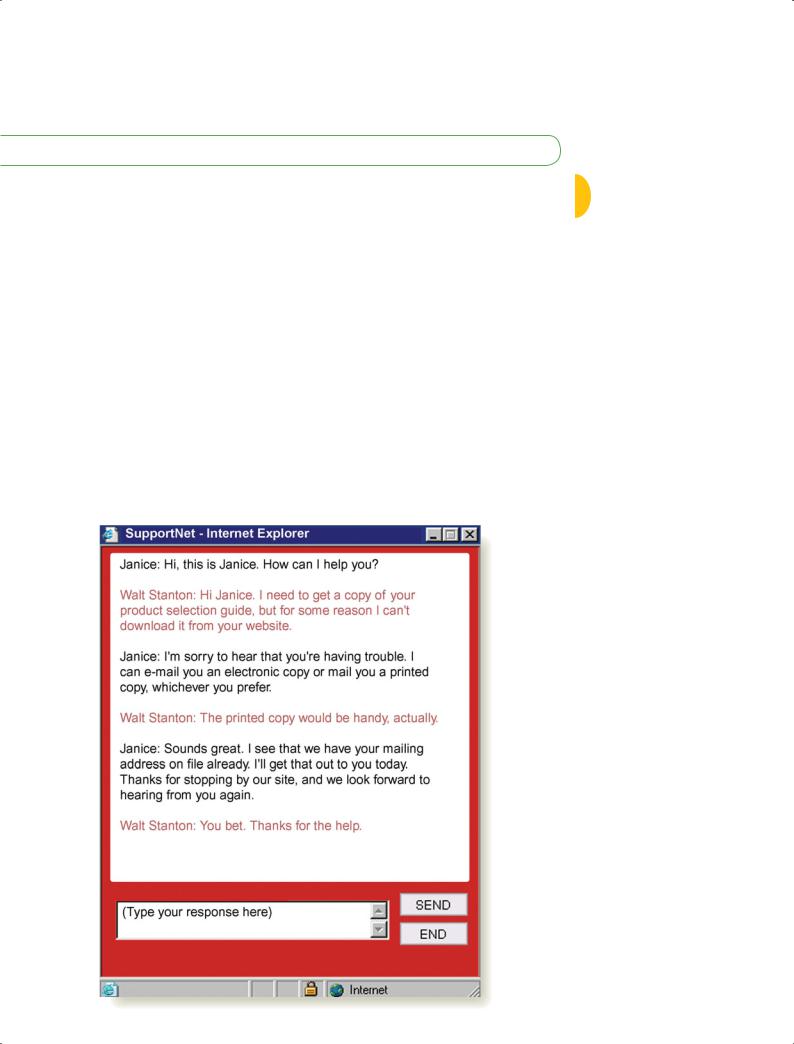
Chapter 7: Writing Routine and Positive Messages |
173 |
anything. Often, a simple thank you is all you need. However, if follow-up action is required or expected, use the close to identify who will do what and when that action will take place.
Common Examples of Routine Replies and Positive Messages
Most routine and positive messages fall into six categories: answers to routine requests, grants of claims and requests for adjustment, recommendations, routine informational messages, good-news announcements, and goodwill messages.
Answering Requests for Information or Action
Every professional answers requests for information or action from time to time. If the response is straightforward, the direct approach is appropriate. A prompt, gracious, and thorough response will positively influence how people think about you and the organization you represent (see Figure 7.4). When you’re answering requests from a potential customer or other decision maker, look for subtle and respectful ways to encourage a decision in your favor.
4 LEARNING OBJECTIVE
Describe six common types of routine replies and positive messages.
Granting Claims and Requests for Adjustment
Even the best-run companies make mistakes, from shipping the wrong order to billing a customer’s credit card inaccurately. In other cases, a customer or a third party might be responsible for a mistake, such as misusing a product or damaging a product in shipment. Each of these events represents a turning point in your relationship with your customer. If you handle the situation well, your customer is likely to be even more loyal than before because you’ve proven that you’re serious about customer satisfaction. However, if a customer believes that you mishandled a complaint, you’ll make the situation even worse. Dissatisfied
Figure 7.4 Effective Response to an Information Request
This quick and courteous exchange is typical of IM communication in such areas as customer service and technical support. The agent (Janice) solves the problem quickly and leaves the customer with a positive impression of the company.
Source: Used with permission from Microsoft.

174 Unit 3: Brief Business Messages
To grant a claim when the customer is at fault, try to discourage future mistakes without insulting the customer.
When a third party is at fault, your response depends on your company’s agreements with that organization.
customers often take their business elsewhere without notice and tell numerous friends and colleagues about the negative experience. A transaction that might be worth only a few dollars by itself could cost you many times that amount in lost business. In other words, every mistake is an opportunity to improve a relationship.
Your response to a customer complaint depends on your company’s policies for resolving such issues and your assessment of whether the company, the customer, or some third party is at fault.
Responding to a Claim When Your Company Is at Fault
Before you respond when your firm is at fault, make sure you know your company’s policies in such cases, which might include specific legal and financial steps to be taken. As a general approach, take the following steps:
■Acknowledge receipt of the customer’s claim or complaint.
■Sympathize with the customer’s inconvenience or frustration.
■Take (or assign) personal responsibility for setting matters straight.
■Explain precisely how you have resolved, or plan to resolve, the situation.
■Take steps to repair the relationship.
■Follow up to verify that your response was correct.
In addition to taking these positive steps, maintain a professional demeanor. Don’t blame anyone in your organization by name; don’t make exaggerated, insincere apologies; don’t imply that the customer is at fault; and don’t promise more than you can deliver.
Responding to a Claim When the Customer Is at Fault
Communication about a claim is a delicate matter when the customer is clearly at fault. If you refuse the claim, you may lose your customer—as well as many of the customer’s friends and colleagues, who will hear only one side of the dispute. You must weigh the cost of making the adjustment against the cost of losing future business from one or more customers. Some companies have strict guidelines for responding to such claims, whereas others give individual employees and managers some leeway in making case-by- case decisions.
If you choose to grant the claim, open with that good news. However, the body needs special attention because you want to discourage similar claims in the future. Close in a courteous manner that expresses your appreciation for the customer’s business (see Figure 7.5).
Responding to a Claim When a Third Party Is at Fault
Some claims are the result of a mistake by a third party, such as a credit card processing company or a delivery service. Your company may not have made the mistake, but the customer could ask you to resolve the matter anyway.
Evaluate each situation carefully and know your company’s policies before responding. For instance, an online retailer and the companies that manufacture its merchandise might have an agreement specifying that the manufacturers automatically handle all complaints about product quality. Regardless of who eventually resolves the problem, though, if customers contact you, you need to respond with messages that explain how the problem will be solved. Pointing fingers is both unproductive and unprofessional. Customers care about only one issue: resolving the situation.
Providing Recommendations and References
Recommendation letters are vulnerable to legal complications, so consult your company’s legal department before writing one.
People who need endorsements from employers or colleagues (when applying for a job, for example) often request letters of recommendation. These messages used to be a fairly routine matter, but employment recommendations and references have raised some complex legal issues in recent years. Employees have sued employers and individual managers for providing negative information or refusing to provide letters of recommendation, and employers have sued other employers for failing to disclose negative information about job
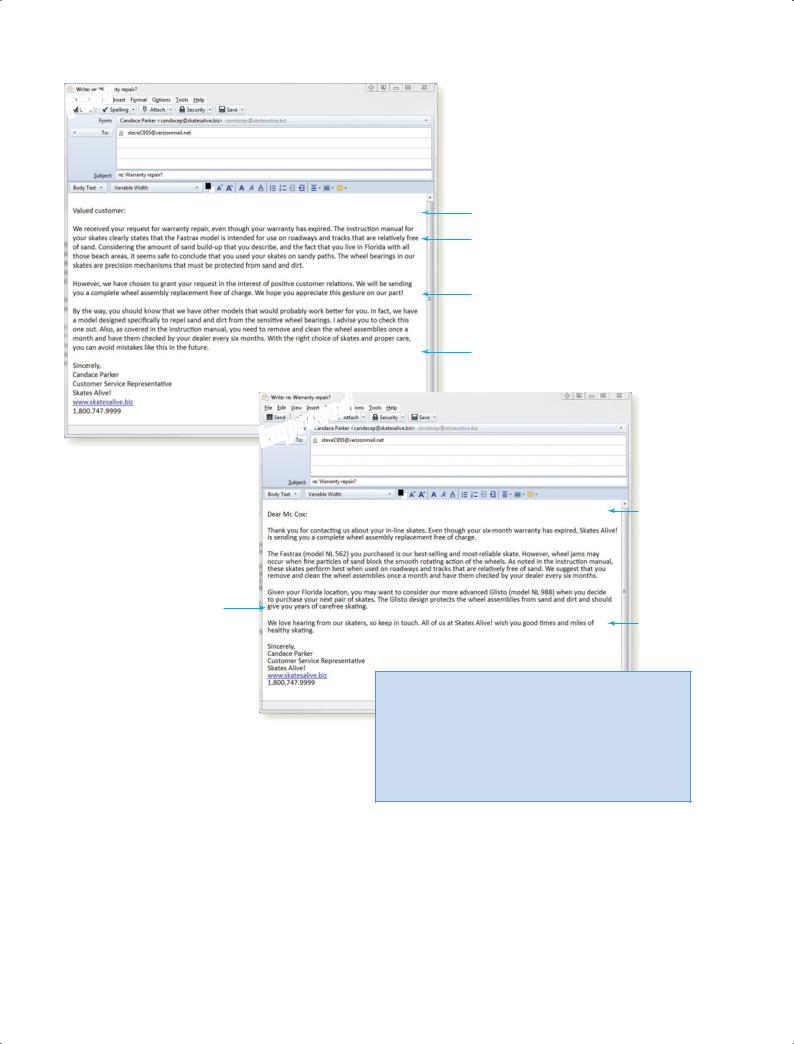
Chapter 7: Writing Routine and Positive Messages |
175 |
Poor
The salutation is cold and impersonal.
The tone is immediately accusatory, and the opening paragraph goes on to insult the customer for not following instructions.
The second paragraph finally delivers the good news but does so in a self-congratulatory way that is likely to destroy whatever goodwill the gesture builds.
The concluding paragraph continues with the high-handed tone and ends on a negative note.
ed Improv
The writer opens by thanking the customer and then delivers the good news. 
The second paragraph explains the  cause of the problem and gently suggests
cause of the problem and gently suggests
that the customer could have prevented it, but does so without insulting or accusing.
The third paragraph offers a specific suggestion for the customer’s next
purchase and does so in a positive way.
The salutation is personal and respectful.
The closing ends the message
on an upbeat, forward-looking note.
Pointers for Granting a Claim
ss Thank the reader for writing. ss Open with the good news.
ss Explain how you’ll grant the claim.
ss Don’t argue with the reader’s version of events.
ss Keep your explanations objective, nonvindictive, and impersonal.
ss Apologize only when appropriate, and do so in a nondramatic fashion. ss Close by encourage a favorable view of your company and its products. ss Clarify any remaining actions the reader should take.
Figure 7.5 Responding to a Claim When the Buyer Is at Fault
Responding to a claim when the buyer is at fault is a positive gesture, so the content and tone of the message need to reflect that. After all, there’s no point in fostering a positive relationship through actions but then undermining that through negative communication. Notice how the poor version sounds like a crabby parent who gives in to a child’s demand but sends a mixed message by being highly critical anyway. The improved version is much more subtle, letting the customer know how to take care of his skates, without blaming or insulting him.
Source: Used with permission from Microsoft.
candidates. Before you write a letter of recommendation for a former employee or provide information in response to another employer’s background check, make sure you understand your company’s policies. Your company may refuse to provide anything more than dates of employment and other basic details, for example.2
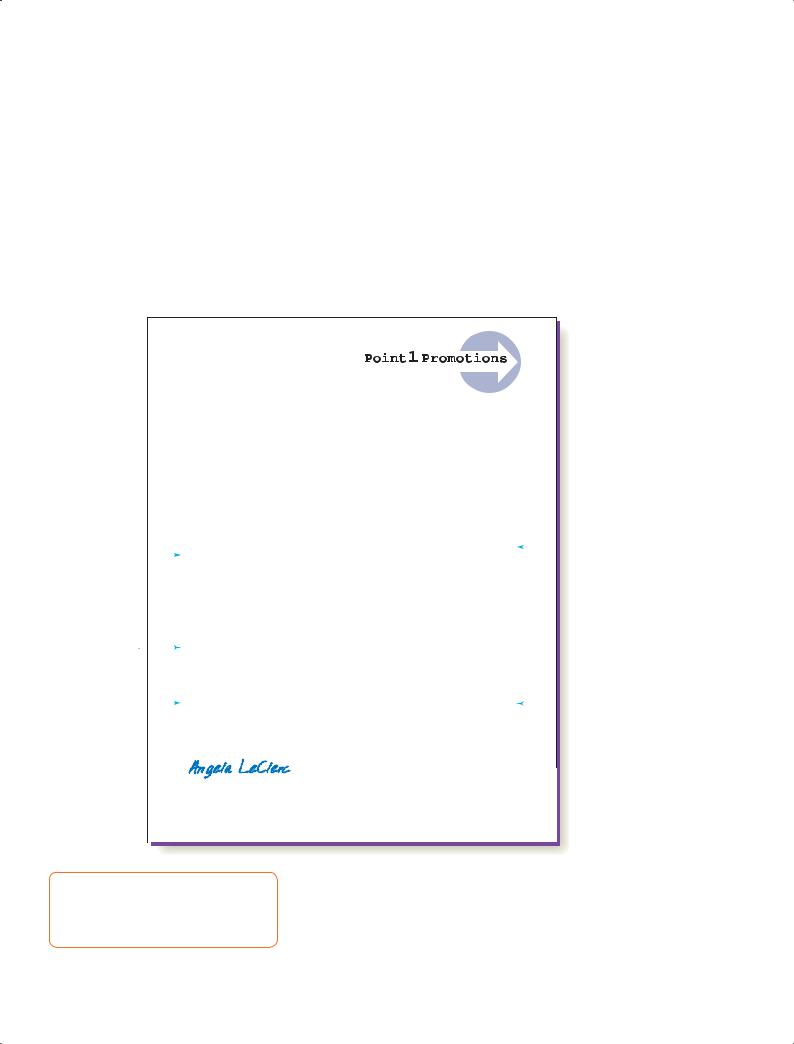
176 Unit 3: Brief Business Messages
If you decide to write a letter of recommendation or respond to a request for information about a job candidate, your goal is to convince readers that the person being recommended has the characteristics necessary for the job, assignment, or other objective the person is seeking. A successful recommendation letter contains a number of relevant details (see Figure 7.6):
■The candidate’s full name
■The position or other objective the candidate is seeking
■The nature of your relationship with the candidate
■Facts and evidence relevant to the candidate and the opportunity
■A comparison of this candidate’s potential with that of peers, if available (for example, “Ms. Jonasson consistently ranked in the top 10 percent of our national salesforce.”)
■Your overall evaluation of the candidate’s suitability for the opportunity
|
|
|
|
105 E. Madison |
|
|
|
|
|
|
|
Ann Arbor, MI 48103 |
|
|
|
|
|
|
|
tel: 800-747-9786 |
|
|
|
|
|
|
|
e-mail: info@point1promo.net |
|
|
|
|
|
|
|
www.point1promo.net |
|
|
|
|
|
|
|
November 14, 2014 |
|
|
|
|
|
|
|
Ms. Clarice Gailey |
|
|
|
|
|
|
|
Director of Operations |
|
|
|
|
|
|
|
McNally and Associates, Inc. |
|
|
|
|
|
|
|
8688 Southgate Ave. |
|
|
|
|
|
|
|
Augusta, GA 30906 |
|
|
|
|
|
|
|
Dear Ms. Gailey: |
|
|
|
|
|
|
|
I am pleased to recommend Talvin Biswas for the marketing position at McNally |
|
The opening clearly |
|
|
|
|
|
|
|||
|
|
|
|
and Associates. Mr. Biswas has worked with Point1 Promotions as an intern for |
|
states candidate’s |
|
|
|
|
|
the past two summers while working toward his degree in marketing and |
|
full name and the |
|
LeClerc specifies |
|
|
advertising. His duties included customer correspondence, web content |
|
main point of the letter. |
||
|
|
updates, and direct-mail campaign planning. |
|
||||
|
|
|
|
||||
the duration and |
|
|
As his supervisor, in addition to knowing his work here, I also know that |
|
|
||
nature of their |
|
|
|
|
|||
relationship in the |
|
|
Mr. Biswas has served as secretary for the International Business Association |
|
|
||
body to give weight |
|
|
at the University of Michigan. He tutored other international students in the |
|
|
||
|
|
university’s writing center. His fluency in three languages (English, French, and |
|
|
|||
to the evaluation. |
|
|
|
|
|||
|
|
Hindi) and thorough knowledge of other cultures will make him an immediate |
|
|
|||
|
|
|
|
|
|
||
|
|
|
|
contributor to your international operations. |
|
|
|
|
|
|
|
|
|
||
|
|
|
|
Mr. Biswas is a thoughtful and careful professional who will not hesitate to |
|
|
|
|
|
|
|
contribute ideas when invited to do so. In addition, because Mr. Biswas learns |
|
|
|
|
|
|
|
quickly, he will learn your company’s routine with ease. |
|
|
|
She closes by |
|
|
|
Mr. Biswas will make an excellent addition to your staff at McNally and |
|
|
The close begins by |
|
|
|
|
|
|||
inviting reader |
|
|
Associates. If I can provide any additional information, please call or fax me at |
|
summarizing the |
||
to discuss the |
|
|
the numbers above. If you prefer to communicate by e-mail, my address is |
|
supportive evaluation. |
||
candidate further. |
|
|
angela_leclerc@point1promo.net. |
|
|
||
|
|
|
|
|
|
||
|
|
|
|
Sincerely, |
|
|
|
|
Angela LeClerc |
Pointers for Writing Recommendation Letters |
|
|
ssTake great care to avoid a lawsuit (either for including too much negative information or for |
||
|
Vice President, Marketing |
||
|
omitting negative information). |
||
|
|
||
|
|
ssFollow your company’s policies in all details; verify only the dates of employment and job |
|
|
|
titles if that is all the information your company allows to be released. |
|
|
|
ssRelease information only to people who have written authorization from the former employee. |
|
|
|
||
|
|
ssConsider collaborating with the former employee so that the contents of the letter meet both |
|
MyBCommLab Apply Figure 7.6’s |
of your needs. |
||
ssIf you are unable or unwilling to represent your company in a professional capacity, offer to |
|||
|
|
||
key concepts. Go to mybcommlab.com |
be a personal reference instead. |
||
ssComment only on your direct experience working with the former employee. |
|||
and follow this path: Course Content |
|||
ssLimit your remarks to provable facts; avoid hyperbole. |
|||
Chapter 7 DOCUMENT MAKEOVERS |
|||
ssAsk your human resource department to review the letter before you send it. |
|||
|
|
|
|
Figure 7.6 Effective Recommendation Letter
This letter clearly states the nature of the writer’s relationship to the candidate and provides specific examples to support the writer’s endorsements.
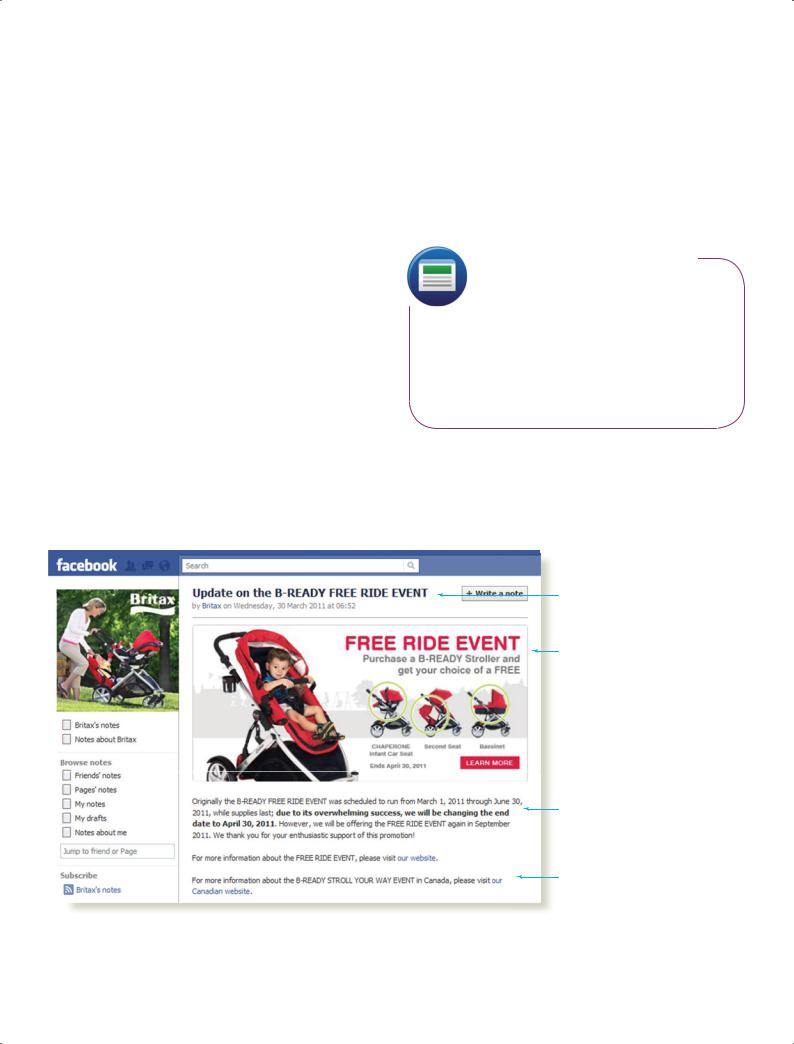
Chapter 7: Writing Routine and Positive Messages |
177 |
Sharing Routine Information
Many messages involve sharing routine information, such as project updates and order status notifications. Use the opening of these routine messages to state the purpose and briefly mention the nature of the information you are providing. Provide the necessary details in the body and end your message with a courteous close (see Figure 7.7).
Most routine communications are neutral. That is, they stimulate neither a positive nor a negative response from readers. For example, when you send departmental meeting announcements and reminder notices, you’ll generally receive a neutral response from your readers (unless the purpose of the meeting is unwelcome). Simply present the factual information in the body of the message, and don’t worry too much
about the reader’s attitude toward the information.
Some routine informative messages may require additional care. For instance, policy statements or procedural changes may be good news for a company, perhaps by saving money. However, it may not be obvious to employees that such savings may make additional employee resources available or even lead to pay raises. In instances in which the reader may not initially view the information positively, use the body of the message to highlight the potential benefits from the reader’s perspective. (For situations in which negative news will have a profound effect on the recipients, consider the indirect techniques discussed in Chapter 8.)
When sharing routine information
■State the purpose at the beginning and briefly mention the nature of the information you are providing
■Provide the necessary details
■End with a courteous close
Announcing Good News
To develop and maintain good relationships, smart companies recognize that it’s good business to spread the word about positive developments. Such developments can include opening new facilities, hiring a top executive, introducing new products or services, or sponsoring community events. Because good news is always welcome, use the direct approach.
The note has a clear and concise title that avoids puns and wordplay.
Facebook Notes lets writers include photos and other images
in their notes.
The note is succinct while emphasizing the most vital point (that a previously announced purchase promotion was ending early).
The note directs U.S. and Canadian customers to separate websites, thereby providing each audience with the specific information
it needs.
Figure 7.7 Sharing Routine Information
Many companies use the Notes tab on their Facebook pages to share routine informational messages with their customers and other parties.
Source: Copyright © 2012 by the Reynolds Communications Group. Reprinted with permissions.

178 Unit 3: Brief Business Messages
A news release or press release is a message (usually routine, but not always) designed to share information with the news media, although many are now written with customers and other stakeholders in mind as well.
The social media release includes share-ready content that is easy to reuse in blog posts, tweets, and other social media formats.
External good-news announcements are often communicated in a news release, also known as a press release, a specialized document used to share relevant information with the news media. (News releases are also used to announce negative news, such as plant closings.) In most companies, news releases are usually prepared or at least supervised by specially trained writers in the public relations department. The content follows the customary pattern for a positive message: good news followed by details and a positive close. However, traditional news releases have a critical difference: You’re not writing directly to the ultimate audience (such as the readers of a newspaper); you’re trying to interest an editor or a reporter in a story, and that person will then write the material that is eventually read by the larger audience. To write a successful news release, keep the following points in mind:3
■Above all else, make sure your information is newsworthy and relevant to the specific publications or websites to which you are sending it.
■Focus on one subject; don’t try to pack a single news release with multiple, unrelated news items.
■Put your most important idea first. Don’t force editors to hunt for the news.
■Be brief: Break up long sentences and keep paragraphs short.
■Eliminate clutter, such as redundancy and extraneous facts.
■Be as specific as possible.
■Minimize self-congratulatory adjectives and adverbs; if the content of your message is newsworthy, the media professionals will be interested in the news on its own merits.
■Follow established industry conventions for style, punctuation, and format.
Until recently, news releases were crafted in a way to provide information to reporters, who would then write their own articles if the subject matter was interesting to their readers. Thanks to the Internet and social media, however, the nature of the news release is changing. Many companies now view it as a general-purpose tool for communicating directly with customers and other audiences, creating direct-to-consumer news releases.4
The newest twist on news releases is the social media release, which has several advantages over the traditional release (see Figure 7.8). First, the social media release includes bullet-point content that is blogand Twitter-friendly, making it easy for enthusiasts and others to share key points. Second, as an electronic-only document (a specialized webpage, essentially), the social media release offers the ability to include videos and other multimedia elements. Third, social bookmarking buttons make it easy for people to help publicize the content.5
Goodwill is the positive feeling that encourages people to maintain a business relationship.
Many routine messages can be adapted to foster goodwill, either by sharing helpful information or providing an element of entertainment.
Using routine messages to entertain customers can be a good way to build goodwill, but it must be done effectively and only when appropriate.
Fostering Goodwill
All business messages should be written with an eye toward fostering positive relationships with audiences, but some messages are written specifically to build goodwill. You can use these messages to enhance your relationships with customers, colleagues, and other businesspeople by sending friendly, even unexpected, notes with no direct business purpose. Whether you’re thanking an employee for a job well done or congratulating a colleague for a personal or professional achievement, the small effort to send a goodwill message can have a positive and lasting effect on the people around you.
In addition to creating messages for a specific goodwill reason, you can craft almost any routine message in a way to build goodwill. Two ways to do this are by providing information that your readers might find helpful and by using the content and tone of your message to provide an element of entertainment. For example, if you send monthly billing statements to customers, you can include tips on how to save money by using your products in a more efficient manner.
Using routine messages to entertain customers can be an effective goodwill builder, if it is done well and doesn’t detract from the primary purpose of the message. One of the bestknown examples is the shipping notification email message that online music retailer CDBaby sends its customers. Company founder Derek Sivers says the original routine message (“Your order has shipped today. Please let us know if it doesn’t arrive. Thank you for your business.”) didn’t fit his mission to “make people smile.”
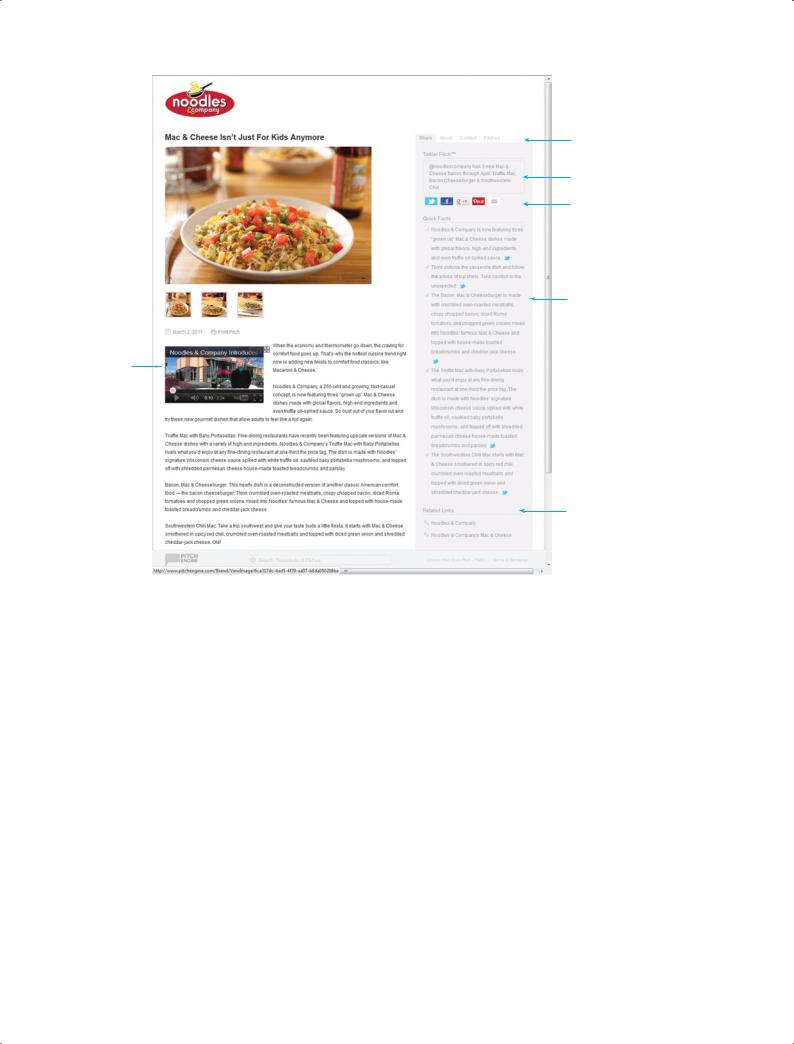
Chapter 7: Writing Routine and Positive Messages |
179 |
Additional information is available through these other tabs.
A variety of product  photos are available
photos are available
for download and social sharing.
An embedded clip provides a video version of the news release.
The full-text version  of the news release message is available
of the news release message is available
for reading and easy sharing.
Figure 7.8 Social Media News Release
The social media release is a news release designed to enable quick and easy sharing via social networks and other media. This particular format was created by the social media agency PitchEngine and emphasizes Twitter-friendly content.
The high-level message is condensed to a single Twitter-friendly “sound bite.”
Social media and email buttons make it easy for anyone to share this page.
The full narrative on the left is “bulletized” here on the right, which helps bloggers and others create their own story. Each bullet also has a Twitter button, which lets readers send the bullet point as an individual tweet.
Related links take readers to the company’s main website or the specific product webpage.
Source: Copyright © 2012 by Noodles and Company. Reprinted with permission.
Sivers replaced that short, serious message with a comically over-the-top message that starts with “Your CD has been gently taken from our CD Baby shelves with sterilized con- tamination-free gloves and placed onto a satin pillow” and continues with such lines as “Our packing specialist from Japan lit a candle and a hush fell over the crowd as he put your CD into the best gold-lined box that money can buy.” The message was a hit with customers, who forwarded it to friends and posted it online, which led to thousands of new customers for the young company.6
Obviously, attempts to entertain customers must be appropriate for the situation. A funny message is great for a music retailer, but it would not be for a bank, a hospital, or any other firm that deals with more serious matters.
Sending Congratulations
One prime opportunity for sending goodwill messages is to congratulate individuals or companies for significant business achievements—perhaps for being promoted or for attaining product sales milestones (see Figure 7.9). Other reasons for sending congratulations include highlights in people’s personal lives, such as weddings, births, graduations, and success in nonbusiness competitions. You may congratulate business acquaintances on their own achievements or on the accomplishments of a spouse or child. You may also take note of personal events, even if you don’t know the reader well. If you’re already friendly with the reader, a more personal tone is appropriate.
Taking note of significant events in someone’s personal life helps foster the business relationship.
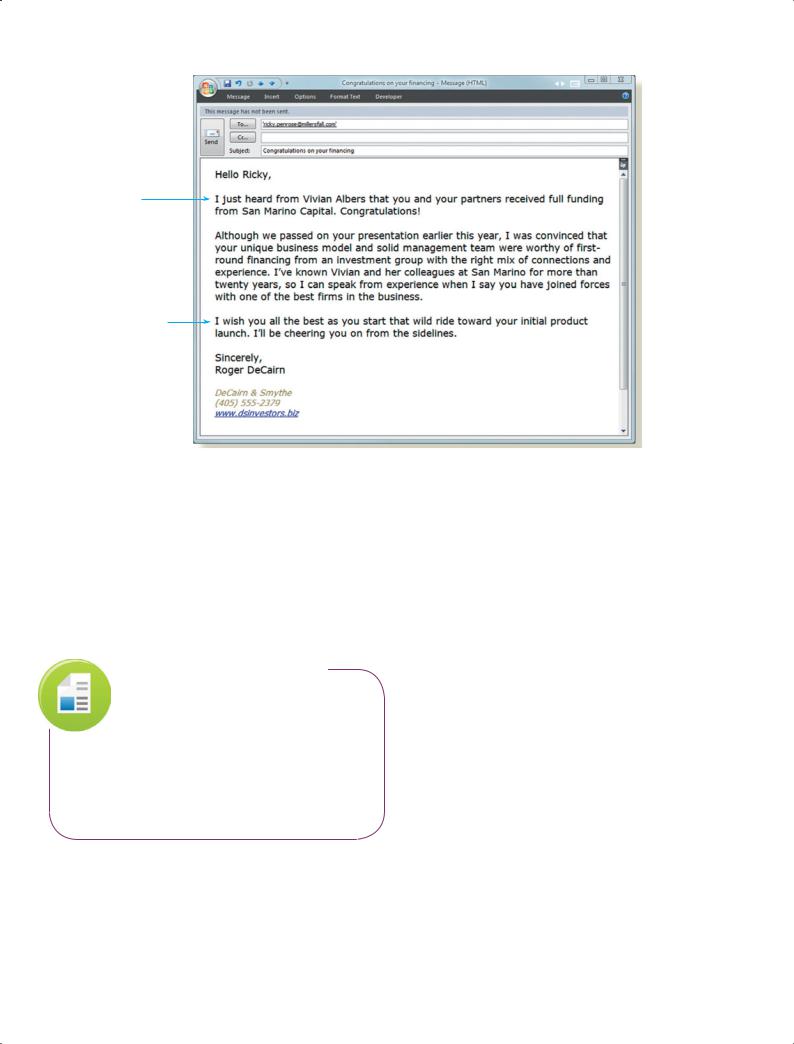
180 Unit 3: Brief Business Messages
The opening offers a positive and sincere expression of congratulations.
The body reminds the
recipient of his previous  meeting and offers specific
meeting and offers specific
points about the recipient’s worthiness in a way that compliments without exaggerating.
The close maintains the upbeat tone and keeps
the focus on the recipient.
Figure 7.9 Goodwill Messages
Goodwill messages serve a variety of business functions. In this email message, investor Roger DeCairn congratulates an entrepreneur who had previously sought start-up capital from his firm but later secured funding from another firm. The message may ultimately benefit DeCairn and his company by building goodwill, but it doesn’t serve an immediate business purpose.
Source: Used with permission from Microsoft.
|
Sending Messages of Appreciation |
An effective message of appreciation |
An important leadership quality is the ability to recognize the contributions of employees, |
documents a person’s contributions. |
colleagues, suppliers, and other associates. Your praise does more than just make the person |
|
feel good; it encourages further excellence. A message of appreciation may also become an |
REAL-TIME UPDATES |
important part of someone’s personnel file, so provide spe- |
|
cific information wherever possible, as in this example: |
||
|
Learn More by Reading This Article
Simple rules for writing effective thank-you notes
These tips are easy to adapt to any business or social occasions in which you need to express appreciation. Go to http://real-timeupdates.com/bce6 and click on Learn More. If you are using MyBCommLab, you can access Real-Time Updates within each chapter or under Student Study Tools.
Thank you and everyone on your team for the heroic efforts you took to bring our servers back up after last Friday’s flood. We were able to restore business right on schedule first thing Monday morning. You went far beyond the level of contractual service in restoring our data center within 16 hours. I would especially like to highlight the contribution of networking specialist Julienne Marks, who worked for 12 straight hours to reconnect our Internet service. If I can serve as a reference in your future sales activities, please do not hesitate to ask.
The primary purpose of condolence messages is to let the audience know that you and the organization you represent care about the person’s loss.
Hearing a sincere thank you can do wonders for morale.7 Moreover, in today’s electronic media environment, a handwritten thank-you note can be a particularly welcome acknowledgment.8
Offering Condolences
Condolence letters are brief personal messages written to comfort someone after the death of a loved one. You may have occasion to offer condolences to employees or other business associates (when the person has lost a family member) or to the family of an employee or business associate (when that person has died).

Chapter 7: Writing Routine and Positive Messages |
181 |
These messages can feel intimidating to write, but they don’t need to be. Follow these three principles: short, simple, and sincere. You don’t need to produce a work of literary art; the fact that you are writing sends a message that is as meaningful as anything you can say.
Timing and media choice are important considerations with condolence letters. The sooner your message is received, the more comforting it will be, so don’t delay. And unless circumstances absolutely leave you no choice, do not use electronic media. A brief, handwritten note on quality stationery is the way to go.
Open a condolence message with a simple expression of sympathy, such as “I am deeply sorry to hear of your loss” or “I am sorry for your loss.” How you continue from there depends on the circumstances and your relationships with the deceased and the person to whom you are writing. For example, if you are writing to the husband of a colleague who recently died and you have never met him, you might continue with “Having worked with Janice for more than a decade, I know what a kind and caring person she was.” Such a statement accomplishes two goals: explaining why you in particular are writing and letting the recipient know that his loved one was appreciated in the workplace.
Conversely, if you are writing to a colleague who recently lost a loved one, you might continue with “After meeting Warren at last year’s company picnic and hearing your stories about his involvement with your son’s soccer league and the many other ways he contributed to his community, I know what a special person he was.” Sharing brief and positive memories like this adds meaning and depth to your expression of sympathy.
You can conclude with a simple statement such as “My thoughts are with you during this difficult time.” If appropriate for the situation and your relationship, you might also include an offer of assistance. “Please call if there is anything I do for you.”
As you decide what to include in the message, keep two points in mind. First, make it a personal expression of sympathy, but don’t make the whole message about you and your sense of loss. You might be grieving as well, but unless you, the deceased, and the reader were all personally close, don’t say things like “I was so devastated to hear the news about Mollie.”
Second, don’t offer “life advice,” and don’t include trite sayings that you may have heard or read. At this point, soon after the loss, the recipient doesn’t want your advice, only your sympathy. Also, don’t bring religion into the discussion unless you have a close personal relationship with the recipient and religion is already a part of your relationship. Otherwise, you risk offending with unwelcome or inappropriate sentiments.
Condolence letters are the most personal business messages you may ever have to write, so they require the utmost in care and respect for your reader. By keeping the messages simple, short, and sincere, you will be able to achieve the right tone.
For the latest information on writing routine and positive messages, visit http://realtimeupdates.com/bce6 and click on Chapter 7.
Keep your condolence message focused on the recipient, not on your own emotions, and don’t offer “life advice” or trite sayings.
